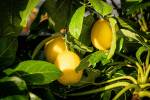Vegetable transplants available at orchard
This Saturday from 9 to 11 a.m. I will have vegetable transplants available at the University of Nevada Cooperative Extension Master Gardener's Orchard in North Las Vegas for planting in home gardens. These transplants are duplicates of what we are planting at the orchard and are ready to be planted right away. They are very reasonably priced so you can try what we are evaluating. These include tomatoes, eggplants and herbs.
For a list you can e-mail me at morrisr@unce.unr.edu. For directions to the orchard, call 257-5555 before Saturday morning.
There is a very good video on starting seeds at home which can be seen on the Internet at http://www.territorialseed.com/Videos_Seed_Starting_2010/?r=JWEJAN3_B4.
Q: Over the summer, primarily late July and August, my lawn "threw up" at night. The first set of photos I sent to you shows the substance, which was white in color, wet and smelling strongly of some sort of fungus. This always occurred late at night.
Each time the lawn "threw up" it was in a different place of this patch of lawn. This patch faces directly south. When I would get up in the morning, the substance would turn red/coral, harden and become crusty, as depicted in the second set of photos. I would seriously like to avoid this occurring again this summer, but first I must find out what it is and, secondly, how to prevent it.
A: Thanks for your e-mail and very nice pictures. They helped me considerably. (If readers want to see this lawn "throwing up," e-mail me and get my free weekly newsletter.)
This is not an uncommon problem in both lawns and wood mulches in landscape plantings. We see it quite often in the orchard because of the use of wood mulch. It is not a disease but it is a fungus.
The fungus is called slime mold and is very similar to mushrooms but this mushroom has no shape and it does resemble "throw up." This fungus is responsible for breaking down organic matter in the soil, part of a very natural process. The problem it causes for a lawn is that it can grow and smother or suffocate the grass beneath it. It can grow quite large.
I would not recommend any chemicals to prevent it as it will disappear as the organic matter breaks down and is exhausted. I am guessing that there is some sort of wood product in the soil beneath your lawn that this fungus is helping break down. It was probably incorporated into the soil during soil preparation. When it is fully broken down, the slime mold will no longer appear.
The easiest way to deal with this problem is to destroy it with a rake as soon as you see it and then wash it into the soil surface with a forceful stream of water from a hose.
Q: I'm up at the north end of the Las Vegas Valley and two years ago I had two bottle trees planted. While one of them has tended to always be slightly taller and bigger, they have been very stout, low-maintenance trees, and I've been looking forward to them growing and filling out.
However during January or so, the taller, stronger looking of the two trees began to develop wilted and dying leaves. Now, about two-thirds of the leaves are brown, dead or falling off. If the other bottle tree wasn't still completely full and green I would think it looked like winter dieback.
A: Bottle tree is an Australian native that grows well in arid regions and so would be considered a desert-adapted species. For this reason, it will not do well if watered too frequently and will get diseases such as root rots.
However, giving this tree more water than it requires will speed up its growth and people want that, at least for awhile. Even though root rots typically develop during warm weather they can still develop during cold weather if we water too often. We must give the soil a chance to "breathe" between irrigations.
However, I think your situation may not be related to watering. Bottle trees are evergreen but they are also sensitive to cold temperatures and the leaves will get damaged during low temperatures.
Bottle trees are started from seed. Because they are started from seed they can have tremendous variability in how they look and how they will respond to our environment.
Some may be more sensitive to cold temperatures than others. There is no real way to determine this until we get them into cold weather and observe them.
If your watering has been long, deep and infrequent, then the damage is most likely from cold weather and not disease. It would be highly unlikely to see the kind of leaf damage you are referring to develop during cold weather as a result of root damage.
If it is from root disease, then try pushing on the two trees and see if they are anchored firmly in the soil. At two years in the ground, both of these trees should be firmly anchored and not move when pushing them.
Bob Morris is an associate professor with the University of Nevada Cooperative Extension. Direct gardening questions to the master gardener hot line at 257-5555 or contact Morris by e-mail at morrisr@unce.unr.edu.























